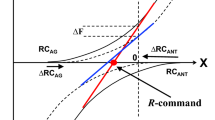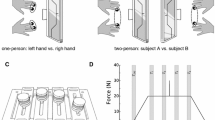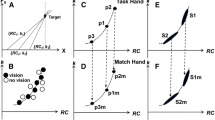Abstract
We explored changes in the cyclical two-finger force performance task caused by turning visual feedback off performed either by the index and middle fingers of the dominant hand or by two index fingers of two persons. Based on an earlier study, we expected drifts in finger force amplitude and midpoint without a drift in relative phase. The subjects performed two rhythmical tasks at 1 Hz while paced by an auditory metronome. One of the tasks required cyclical changes in total force magnitude without changes in the sharing of the force between the two fingers. The other task required cyclical changes in the force sharing without changing total force magnitude. Subjects were provided with visual feedback, which showed total force magnitude and force sharing via cursor motion along the vertical and horizontal axes, respectively. Further, visual feedback was turned off, first on the variable that was not required to change and then on both variables. Turning visual feedback off led to a mean force drift toward lower magnitudes while force amplitude increased. There was a consistent drift in the relative phase in the one-hand task with the index finger leading the middle finger. No consistent relative phase drift was seen in the two-person tasks. The shape of the force cycle changed without visual feedback reflected in the lower similarity to a perfect cosine shape and in the higher time spent at lower force magnitudes. The data confirm findings of earlier studies regarding force amplitude and midpoint changes, but falsify predictions of an earlier proposed model with respect to the relative phase changes. We discuss factors that could contribute to the observed relative phase drift in the one-hand tasks including the leader–follower pattern generalized for two-effector tasks performed by one person.









Similar content being viewed by others
References
Ambike S, Mattos D, Zatsiorsky VM, Latash ML (2016a) The nature of constant and cyclic force production: Unintentional force-drift characteristics. Exp Brain Res 234:197–208
Ambike S, Mattos D, Zatsiorsky VM, Latash ML (2016b) Unsteady steady-states: central causes of unintentional force drift. Exp Brain Res 234:3597–3611
Ambike S, Mattos D, Zatsiorsky VM, Latash ML (2018) Systematic, unintended drifts in the cyclic force produced with the fingertips. Mot Control 22:82–99
Bosga J, Meulenbroek RG, Cuijpers RH (2010) Intra- and interpersonal movement coordination in jointly moving a rocking board. Mot Control 14:440–459
Candidi M, Curioni A, Donnarumma F, Sacheli LM, Pezzulo G (2015) Interactional leader-follower sensorimotor communication strategies during repetitive joint actions. J R Soc Interface 12(110):0644
Carson RG (1995) The dynamics of isometric bimanual coordination. Exp Brain Res 105:465–476
Davis TJ, Pinto GB, Kiefer AW (2017) The stance leads the dance: the emergence of role in a joint supra-postural task. Front Psychol 8:718
Debaere F, Van Assche D, Kiekens C, Verschueren SM, Swinnen SP (2001) Coordination of upper and lower limb segments: deficits on the ipsilesional side after unilateral stroke. Exp Brain Res 141:519–529
Debaere F, Wenderoth N, Sunaert S, Van Hecke P, Swinnen SP (2003) Internal vs. external generation of movements: differential neural pathways involved in bimanual coordination performed in the presence or absence of augmented visual feedback. Neuroimage 19:764–776
Feldman AG (1980) Superposition of motor programs. I. Rhythmic forearm movements in man. Neurosci 5:81–90
Fitts PM (1954) The information capacity of the human motor system in controlling the amplitude of movement. J Exp Psychol 47:381–391
Feldman AG (2015) Referent control of action and perception: Challenging conventional theories in behavioral science. Springer, NY
Ganesh G, Takagi A, Osu R, Yoshioka T, Kawato M, Burdet E (2014) Two is better than one: physical interactions improve motor performance in humans. Sci Rep 4:3824
Gorniak SL, Duarte M, Latash ML (2008) Do synergies improve accuracy? A study of speed-accuracy trade-offs during finger force production. Mot Control 12:151–172
Haken H, Kelso JAS, Bunz H (1985) A theoretical model of phase transitions in human hand movements. Biol Cybern 51:347–356
Jo HJ, Ambike S, Lewis MM, Huang X, Latash ML (2016) Finger force changes in the absence of visual feedback in patients with Parkinson’s disease. Clin Neurophysiol 127:684–692
Kay BA, Kelso JAS, Saltzman EL, Schoner G (1987) Space-time behavior of single and bimanual rhythmical movements: data and limit cycle model. J Exp Psychol Hum Percept Perform 13:178–192
Kelso JAS (1995) Dynamic patterns: The self-organization of brain and behavior. MIT Press, Cambridge
Kelso JAS, DelColle JD, Schöner G (1990) Action-perception as a pattern formation process. Attention performance XIII 5:139–169
Kennedy D, Rhee J, Shea CH (2016) Symmetrical and asymmetrical influences on force production in 1:2 and 2:1 bimanual force coordination tasks. Exp Brain Res 234:287–300
Kovacs AJ, Buchanan JJ, Shea CH (2009) Bimanual 1:1 with 90 degrees continuous relative phase: difficult or easy. Exp Brain Res 193:129–136
Kovacs AJ, Buchanan JJ, Shea CH (2010) Impossible is nothing: 5:3 and 4:3 multi-frequency bimanual coordination. Exp Brain Res 201:249–259
Lafe CW, Pacheco MM, Newell KM (2016a) Adapting relative phase of bimanual isometric force coordination through scaling visual information intermittency. Hum Mov Sci 47:186–196
Lafe CW, Pacheco MM, Newell KM (2016b) Bimanual coordination and the intermittency of visual information in isometric force tracking. Exp Brain Res 234:2025–2034
Lamb PF, Stöckl M (2014) On the use of continuous relative phase: Review of current approaches and outline for a new standard. Clin Biomech 29:484–493
Latash ML (2010) Motor synergies and the equilibrium-point hypothesis. Mot Control 14:294–322
Latash ML (2016) Towards physics of neural processes and behavior. Neurosci Biobehav Rev 69:136–146
Latash ML (2017) Biological movement and laws of physics. Mot Control 21:327–344
Latash ML, Zatsiorsky VM (1993) Joint stiffness: Myth or reality? Hum Move Sci 12: 653-692
Latash ML, Zatsiorsky VM (2016) Biomechanics and motor control: defining central concepts. Academic Press, New York
Levy-Tzedek S, Ben Tov M, Karniel A (2011) Rhythmic movements are larger and faster but with the same frequency on removal of visual feedback. J Neurophysiol 106:2120–2126
Li ZM, Latash ML, Zatsiorsky VM (1998) Force sharing among fingers as a model of the redundancy problem. Exp Brain Res 119:276–286
Li ZM, Zatsiorsky VM, Latash ML (1999) Contributions of the extrinsic and intrinsic hand muscles to the moments in finger joints. J Clin Biomechs 15:203–211
Li S, Danion F, Latash ML, Li Z-M, Zatsiorsky VM (2000) Characteristics of finger force production during one- and two-hand tasks. Hum Move Sci 19:897–924
Li ZM, Zatsiorsky VM, Latash ML (2001) The effect of finger extensor mechanism on the flexor force during isometric tasks. J Biomechs 34:1097–1102
Mechsner F, Kerzel D, Knoblich G, Prinz W (2001) Perceptual basis of bimanual coordination. Nature 414:69–73
Mojtahedi K, Whitsell B, Artemiadis P, Santello M (2017) Communication and inference of intended movement direction during human-human physical interaction. Front Neurorobot 11:21
Mushiake H, Inase M, Tanji J (1991) Neuronal activity in the primate premotor, supplementary, and precentral motor cortex during visually guided and internally determined sequential movements. J Neurophysiol 66:705–718
Oliveira MA, Hsu J, Park J, Clark JE, Shim JK (2008) Age-related changes in multi-finger interactions in adults during maximum voluntary finger force production tasks. Hum Mov Sci 27:714–727
Parsa B, O’Shea DJ, Zatsiorsky VM, Latash ML (2016) On the nature of unintentional action: A study of force/moment drifts during multi-finger tasks. J Neurophysiol 116:698–708
Parsa B, Terekhov A, Zatsiorsky VM, Latash ML (2017) Optimality and stability of intentional and unintentional actions: I. Origins of drifts in performance. Exp Brain Res 235:481–496
Poon C, Chin-Cottongim LG, Coombes SA, Corcos DM, Vaillancourt DE (2012) Spatiotemporal dynamics of brain activity during the transition from visually guided to memory-guided force control. J Neurophysiol 108:1335–1348
Reed KB, Peshkin MA (2008) Physical collaboration of human-human and human-robot teams. IEEE Trans Haptics 1:108–120
Reschechtko S, Latash ML (2017) Stability of hand force production: I. Hand level control variables and multi-finger synergies. J Neurophysiol 118:3152–3164
Reschechtko S, Zatsiorsky VM, Latash ML (2014) Stability of multifinger action in different state spaces. J Neurophysiol 112:3209–3218
Reschechtko S, Hasanbarani F, Akulin VM, Latash ML (2017) Unintentional force changes in cyclical tasks performed by an abundant system: Empirical observations and a dynamical model. Neurosci 350:94–109
Reschechtko S, Cuadra C, Latash ML (2018) Force illusions and drifts observed during muscle vibration. J Neurophysiol. https://doi.org/10.1152/jn.00563.2017. (in press)
Sainburg RL (2005) Handedness: differential specializations for control of trajectory and position. Exerc Sport Sci Rev 33:206–213
Schieber MH (1999) Voluntary descending control. In: Zigmond MJ, Bloom FE, Landis SC, Roberts JL, Squire LR (eds) Fundamental neuroscience. Academic Press, San Diego etc, pp 931–949
Schoner G, Kelso JAS (1988) Dynamic pattern generation in behavioral and neural systems. Science 239:1513–1520
Shim JK, Oliveira MA, Hsu J, Huang J, Park J, Clark JE (2007) Hand digit control in children: age-related changes in hand digit force interactions during maximum flexion and extension force production tasks. Exp Brain Res 176:374–386
Slifkin AB, Vaillancourt DE, Newell KM (2000) Intermittency in the control of continuous force production. J Neurophysiol 84:1708–1718
Solnik S, Reschechtko S, Wu Y-H, Zatsiorsky VM, Latash ML (2016) Interpersonal synergies: Static prehension tasks performed by two actors. Exp Brain Res 234:2267–2282
Solnik S, Qiao M, Latash ML (2017) Effects of visual feedback and memory on unintentional drifts in performance during finger pressing tasks. Exp Brain Res 235:1149–1162
Sternad D, Collins D, Turvey MT(1995) The detuning factor in the dynamics of interlimb rhythmic coordination.Biol Cybern73:27–35
Sternad D, Turvey MT, Saltzman EL (1999) Dynamics of 1:2 coordination: Sources of symmetry breaking. J Mot Behav 31:224–235
Vaillancourt DE, Russell DM (2002) Temporal capacity of short-term visuomotor memory in continuous force production. Exp Brain Res 145:275–285
Vaillancourt DE, Slifkin AB, Newell KM (2001) Visual control of isometric force in Parkinson’s disease. Neurophysiologia 39:1410–1418
Vaillancourt DE, Thulborn KR, Corcos DM (2003) Neural basis for the processes that underlie visually guided and internally guided force control in humans. J Neurophysiol 90:3330–3340
Wilson AD, Bingham GP (2008) Identifying the information for the visual perception of relative phase. Percept Psychophys 70:465–476
Wilson AD, Bingham GP, Craig JC (2003) Proprioceptive perception of phase variability. J Exp Psychol Hum Percept Perform 29:1179–1190
Wilson AD, Snapp-Childs W, Coats R, Bingham GP (2010) Learning a coordinated rhythmic movement with task-appropriate coordination feedback. Exp Brain Res 205:513–520
Zatsiorsky VM, Li ZM, Latash ML (2000) Enslaving effects in multi-finger force production. Exp Brain Res 131:187–195
Zhang W, Zatsiorsky VM, Latash ML (2006) Accurate production of time-varying patterns of the moment of force in multi-finger tasks. Exp Brain Res 175:68–82
Zhou T, Solnik S, Wu Y-H, Latash ML (2014) Equifinality and its violations in a redundant system: Control with referent configurations in a multi-joint positional task. Mot Control 18:405–424
Acknowledgements
We are very much grateful to Dr. Mehdi Shahbazi for facilitating the visit of Ms. Fariba Hasanbarani to The Pennsylvania State University. The study was in part supported by NIH Grant NS095873.
Author information
Authors and Affiliations
Corresponding author
Rights and permissions
About this article
Cite this article
Hasanbarani, F., Reschechtko, S. & Latash, M.L. Performance drifts in two-finger cyclical force production tasks performed by one and two actors. Exp Brain Res 236, 779–794 (2018). https://doi.org/10.1007/s00221-018-5179-5
Received:
Accepted:
Published:
Issue Date:
DOI: https://doi.org/10.1007/s00221-018-5179-5




